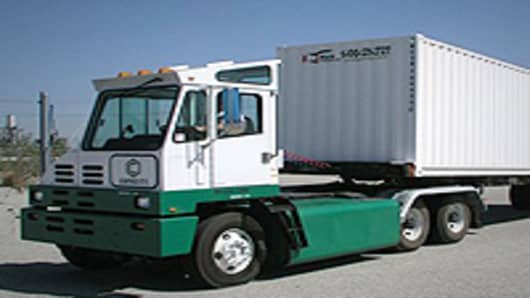An electric-powered 18-wheeler may not be merging onto U.S. highways soon, but the hammer’s down on cleaning up America’s truck fleet.
“Our general thinking is that we need large scale fleets of all-electric long haul trucks as much, or more, as we need to replace the passenger car fleet,” says Garvin Jabusch, CIO of investment advisory firm Green Alpha Advisors. “But with current battery technology, we can only get so far. Batteries now are still heavy, bulky and expensive.”
The environmental and economic arguments are powerful. In the U.S. alone, there are 15,5 million trucks, which consume three-quarters of all diesel fuel. The quarter-of-a-trillion-dollar industry transports 70-percent of the nation's goods and employs 3.5 million drivers.
Nevertheless, expect volatile fuel prices, not concerns about carbon emissions, to be the big driver for an all-electric transport trucks. That means momentum favors advances of other existing “cleaner” truck technologies, like diesel-assisted hybrid drive trains, more efficient engine components and more aerodynamic truck bodies.
“Right now batteries are up against some tough limits,” says Jon Guice, managing director of independent research firm AltaTerra. “The learning and cost curves on liquid fuels is so much stronger.”
The same hybrid technologies used by passenger car manufacturers like Toyota , Honda and Ford offers some benefits for trucks, but even those have limits because of the long-distance travel needs of the business, says Darren Gosbee, director of hybrid strategy and execution at truck-maker Navistar .
“The most beneficial use of hybrids is in stop-and-start applications in urban areas,” he says, where the slowing down helps recover energy. “In a coast-to-coast run, it tends to be less stop-and-go and more steady-state (operation).”
His firm already offers two models of hybrid medium-duty trucks that use Eaton Corp drive trains , and is working on technologies that recover wasted energy in truck engines, now sent up the exhaust pipe as unusable heat.
Some use-specific, all-electric trucks are in the market now.
Electric Vehicles International currently works with Daimler truck division to transplant its electric drive into Daimler’s medium-duty trucks – like walk-in vans and cube trucks – that are typically used daily and are driven back to a depot where they can be recharged overnight.
“We’re going after a specific market, the ‘return to base’ market,” says EVI CEO Ricky Hanna. “That is where electric technology is best, where you have a predefined route.”
Hanna points out that his firm’s technology could extend its range—to point-to-point heavy duty trucking between metropolitan centers in the northeast, for example—but that comes back to the battery issue.
“To be honest, we can go higher, we can put in more batteries,” he says. “But then you’re carrying more, it’s more deadweight.”
Some heavy-duty trucks can also be electrified if they operate as a “return to base” vehicle. Since 2008, the Port of Los Angeles employs electric heavy trucks to transport loaded shipping containers around the port with a top speed of 40 mph and a 60-mile driving range between charges.
Using an emissions-free engine in places like ports can be a smart move for the operator and for the environment; a truck’s combustion engine typically wastes a lot of its energy and pollutes more heavily in stop-and-go situations with heavier loads.
Environmental attributes aside, buyers also need the right return on investment, says Navistar’s Gosbee.
He says his firm’s current and proposed cleaner trucks aim for the same replacement cycle of their diesel counterparts: three to four years for the typical long-haul truck, five to seven years for medium-duty trucks, and 10-12 years for school buses.
“It’s a real opportunity but it comes down to payback on the opportunity,” he says. “It’s a significant capital investment, but picture if diesel fuel gets up to $5 per gallon.”
Hanna estimates payback on his firm’s medium-duty, plug-in electric trucks, without any government incentives, is about seven years. With carbon emissions incentives like those in California, he says it shortens to about three years, when compared to a 6-mpg diesel truck operating similar routes 5-6 days a week year-round, with diesel at $3 per gallon.
He says under those circumstances at the end of the end of the payback period, the savings is about $12,000 per year as opposed to diesel users.
In 2009, diesel fuel prices ranged from $2.00 to $2.90 per gallon in the U.S., according to the Dept. of Energy’s Energy Information Administration, having almost hit $5 per gallon in the summer of 2008. The DOE estimates U. S. refineries produce about 3 million barrels of diesel a day.
Another big obstacle to an all-electric heavy truck fleet is the lack of recharging stations along the major highways.
“There’s just no infrastructure for continuous top-ups,” says Gosbee.
But Green Alpha’s Jabusch feels the coming wider availability of electric passenger cars could prompt both the infrastructure and technology advances needed, and more quickly than anticipated.
“The critical national charging network will be first, because it's the simplest,” he says. “It can be achieved with current technologies and will begin to be developed in earnest very soon with the advent of large scale electric vehicle production.”
He says a recharging-technology joint venture from auto makers Renaultand Nissan is hastening development. “The recharging network is underway and will grow fast,” he says.
Jabusch is also optimistic that improvements in battery size, capacity and price will come sooner than people think.
In the meantime, transitional technologies will carry the load.
“Shorter term, we're okay with plug-in hybrids and/or natural gas solutions,” he says. “But we see them as transitional in both commercial and passenger vehicles.”




